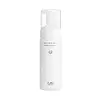What's inside
What's inside
 Key Ingredients
Key Ingredients

 Benefits
Benefits

 Concerns
Concerns

 Ingredients Side-by-side
Ingredients Side-by-side

Water
Skin ConditioningCoco-Glucoside
CleansingGlycerin
HumectantDisodium Cocoamphodiacetate
CleansingButylene Glycol
Humectant1,2-Hexanediol
Skin ConditioningSodium Cocoyl Apple Amino Acids
Skin ConditioningSodium Chloride
MaskingPotassium Cocoyl Glycinate
Sodium Cocoyl Glutamate
CleansingPotassium Cocoate
EmulsifyingHexylene Glycol
EmulsifyingPolyglyceryl-10 Laurate
Skin ConditioningEthylhexylglycerin
Skin ConditioningDisodium EDTA
Tetrasodium Glutamate Diacetate
Sodium Hyaluronate
HumectantPerilla Ocymoides Seed Extract
AntioxidantGlycine
BufferingBambusa Vulgaris Water
Skin ConditioningSerine
MaskingGlutamic Acid
HumectantAspartic Acid
MaskingLeucine
Skin ConditioningAlanine
MaskingLysine
Skin ConditioningArginine
MaskingTyrosine
MaskingPhenylalanine
MaskingProline
Skin ConditioningThreonine
Valine
MaskingIsoleucine
Skin ConditioningCaprylic/Capric Triglyceride
MaskingHistidine
HumectantCysteine
AntioxidantMethionine
Skin ConditioningBisabolol
MaskingHydrogenated Lecithin
EmulsifyingCeramide NP
Skin ConditioningPhytosteryl/Octyldodecyl Lauroyl Glutamate
Skin ConditioningWater, Coco-Glucoside, Glycerin, Disodium Cocoamphodiacetate, Butylene Glycol, 1,2-Hexanediol, Sodium Cocoyl Apple Amino Acids, Sodium Chloride, Potassium Cocoyl Glycinate, Sodium Cocoyl Glutamate, Potassium Cocoate, Hexylene Glycol, Polyglyceryl-10 Laurate, Ethylhexylglycerin, Disodium EDTA, Tetrasodium Glutamate Diacetate, Sodium Hyaluronate, Perilla Ocymoides Seed Extract, Glycine, Bambusa Vulgaris Water, Serine, Glutamic Acid, Aspartic Acid, Leucine, Alanine, Lysine, Arginine, Tyrosine, Phenylalanine, Proline, Threonine, Valine, Isoleucine, Caprylic/Capric Triglyceride, Histidine, Cysteine, Methionine, Bisabolol, Hydrogenated Lecithin, Ceramide NP, Phytosteryl/Octyldodecyl Lauroyl Glutamate
Ingredients Explained
These ingredients are found in both products.
Ingredients higher up in an ingredient list are typically present in a larger amount.
1,2-Hexanediol is a synthetic liquid and another multi-functional powerhouse.
It is a:
- Humectant, drawing moisture into the skin
- Emollient, helping to soften skin
- Solvent, dispersing and stabilizing formulas
- Preservative booster, enhancing the antimicrobial activity of other preservatives
Butylene Glycol (or BG) is used within cosmetic products for a few different reasons:
Overall, Butylene Glycol is a safe and well-rounded ingredient that works well with other ingredients.
Though this ingredient works well with most skin types, some people with sensitive skin may experience a reaction such as allergic rashes, closed comedones, or itchiness.
Learn more about Butylene GlycolGlycerin is already naturally found in your skin. It helps moisturize and protect your skin.
A study from 2016 found glycerin to be more effective as a humectant than AHAs and hyaluronic acid.
As a humectant, it helps the skin stay hydrated by pulling moisture to your skin. The low molecular weight of glycerin allows it to pull moisture into the deeper layers of your skin.
Hydrated skin improves your skin barrier; Your skin barrier helps protect against irritants and bacteria.
Glycerin has also been found to have antimicrobial and antiviral properties. Due to these properties, glycerin is often used in wound and burn treatments.
In cosmetics, glycerin is usually derived from plants such as soybean or palm. However, it can also be sourced from animals, such as tallow or animal fat.
This ingredient is organic, colorless, odorless, and non-toxic.
Glycerin is the name for this ingredient in American English. British English uses Glycerol/Glycerine.
Learn more about GlycerinChances are, you eat sodium chloride every day. Sodium Chloride is also known as table salt.
This ingredient has many purposes in skincare: thickener, emulsifier, and exfoliator.
You'll most likely find this ingredient in cleansers where it is used to create a gel-like texture. As an emulsifier, it also prevents ingredients from separating.
There is much debate on whether this ingredient is comedogenic. The short answer - comedogenic ratings don't tell the whole story. Learn more about comegodenic ratings here.
The concensus about this ingredient causing acne seems to be divided. Research is needed to understand if this ingredient does cause acne.
Scrubs may use salt as the primary exfoliating ingredient.
Learn more about Sodium ChlorideWater. It's the most common cosmetic ingredient of all. You'll usually see it at the top of ingredient lists, meaning that it makes up the largest part of the product.
So why is it so popular? Water most often acts as a solvent - this means that it helps dissolve other ingredients into the formulation.
You'll also recognize water as that liquid we all need to stay alive. If you see this, drink a glass of water. Stay hydrated!
Learn more about Water